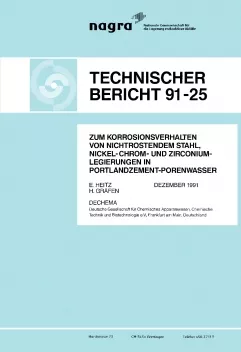
Technischer Bericht NTB 91-25
Zum Korrosionsverhalten von nichtrostendem Stahl, Nickel-Chrom- und Zirconium-Legierungen in Portlandzement-Porenwasser
On the basis of an extensive review of literature and available experience, an evaluation was made of the corrosion of a metallic matrix for radioactive nuclides embedded in porous, water containing Portland cement.
As a metallic matrix, austenitic high-alloy steel, nickel-base alloys and zirconium alloys are discussed. Pore waters in Portland cement have low aggressivity. However, through contact with formation water, chloride and sulphate enrichment can occur. Although corrosion is principally possible on the basis of purely thermodynamic considerations, it can be assumed that local corrosion (pitting, stress corrosion cracking, intergranular corrosion) is highly improbable under the given boundary conditions. This is valid for all three groups of alloys and means that only low release rates of corrosion products are to be expected. As a result of the discussion on radiolysis-induced corrosion, additional corrosion activity can be excluded. Final conclusions concerning the stimulation of corrosion processes by microbial action cannot be drawn and, therefore, additional experiments are proposed.
The release rates of radioactive products are controlled by a very low dissolution rate of the materials in the passive state. All three groups of alloys show this type of general dissolution. From a survey of literature data it can be concluded that release rates greater than 250 mg/m2 per day are not exceeded. Since these data were mainly obtained by electrochemical methods, it is proposed that quantitative analytical investigations of the corrosion products in pore water should be made. On the whole the release rates determined are far below corrosion rates which are generally technically relevant.
